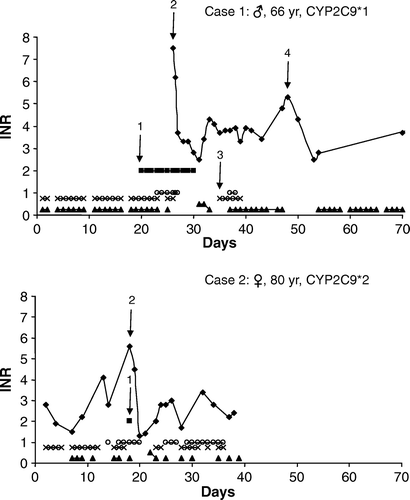To the Editor, Interaction with vitamin K antagonists can lead to serious adverse reactions Citation[1]. Metronidazole inhibits CYP2C9, which metabolizes vitamin K antagonists Citation[2]. Nimorazole is a 5-nitroimidazole, which is closely related to metronidazole in structure and activity. Nimorazole is used as a hypoxic sensitizer concomitantly with radiotherapy for head and neck cancers Citation[3] and could from the similarities with metronidazole theoretically lead to increased effect of anticoagulant therapy Citation[4].
Case 1
A 66 year old man with a glottis carcinoma (T2N0M0) was referred to radiotherapy, 66 Gy in 33 fractions/6 fractions per week with 2 500 mg nimorazole given 1½ hours prior to each fraction. Fifteen years earlier he had a mitral valve prostesis inserted and had since then been treated with phenprocoumon 1.5 mg 6 days per week with stable INR-values around 2.5. At the 16th nimorazole dose he experienced hemoptysis and on the 17th dose, he noted continuous hematuria with no pain (). On the 22nd dose INR was 7.5 and the patient was admitted to hospital. At this time he was also treated with fluconazole, which inhibits CYP2C9 Citation[1], but the bleeding had started before initiation of fluconazole treatment. When the patients INR had normalized, there was still 5 days left of the radiation therapy. With the patient's consent a re-challenge was performed. Thereafter INR increased with 40%, which exceeds the least significant change in the individual (estimated to 23% based on the CV% for INR at the local laboratory). The patient CYP2C9 gene was characterized as CYP2C9*1, which is the wildtype enzyme with normal enzyme activity Citation[5].
Case 2
A 80 year old woman with a hypopharynx cancer (T3N1M0) was referred to radiotherapy with 66 Gy in 33 fractions with 6 fractions/week with 1 500 mg nimorazole 1½ hours before each fraction. Due to atrial fibrillation the patient was treated with phenprocoumon 1.5 mg 3 days per week. The patient had to have a tracheostomy before initiation of radiotherapy and had for this reason discontinued phenprocoumon just before initiation of radiotherapy. She re-started phenprocoumon after the first four doses of nimorazole (). An increase in INR was observed after a few days with concomitant nimorazole and phenprocoumon treatment. At the 13th nimorazole dose INR reached 5.6 and the patient experienced gastrointestinal bleeding with hematemesis and haemoglobin at 4.8 mmol/l (). A few days earlier the patient had started treatment with diclofenac, which was discontinued. In addition, the patient was treated with fluconazole, but the INR increase had started prior to initiation of fluconazole. The patients CYP2C9 gene was CYP2C9*2, which leads to a decrease in enzyme activity as compared to the wildtype enzyme Citation[5].
Discussion
The two cases indicate that nimorazole and phenprocoumon interact. An increased effect of phenprocoumon was observed in as well a patient with normal enzyme activity (CYP2C9*1) as in a patient with a decrease in enzyme activity (CYP2C9*2). A risk during phenprocoumon therapy may be extrapolated to therapy with warfarin, since these therapies are quite comparable.
Both patients were treated with fluconazole, which inhibits CYP2C9, but bleeding occurred prior to fluconazole therapy in case 1 and INR increase occurred prior to fluconazole treatment in case 2. Fluconazole may therefore have worsened the inhibition of CYP2C9 and the degree of severity of this worsening will depend on the mechanism of action of the two inhibitors. If the mechanisms are similar, the total inhibition will be close to the strongest inhibitor of the two. If the mechanisms are different, the total inhibition will be greater than the sum of each inhibitors inhibition.
The mechanism for the enzyme inhibition of nimorazole is unknown but in both cases the effect did not occur until after 2 weeks. This suggests that the mechanism is rather inhibition of the synthesis of enzyme than destruction of the enzyme, where the effect would have occurred faster. An interaction between vitamin K antagonists and nimorazole is potentially more dangerous than the interaction between vitamin K antagonists and metronidazole since the duration of nimorazole therapy is 1½ months but less than one week for metronidazole.
These observations call for an interaction study and ideally also a titration study. Until then oncologists should be particularly careful with patients who receives vitamin K antagonists, when these patients undergo nimorazole treatment. INR should be measured frequently during initiation of nimorazole treatment and the dose of the vitamin K antagonist may need adjustment, since the alternative would be that patients may be discontinued from the nimorazole treatment and therefore are treated less well than patients who do not receive vitamin K antagonist therapy.
Conflicts of interest
None
References
- Wells PS, Holbrook AM, Crowther NR, Hirsh J. Interactions of warfarin with drugs and food. Ann Intern Med 1994; 121: 676–83
- O'Reilly RA. The stereoselective interaction of warfarin and metronidazole in man. N Engl J Med 1976; 295: 354–7
- Overgaard J, Hansen HS, Overgaard M, Bastholt L, Berthelsen A, Specht L, et al. A randomized double-blind phase III study of nimorazole as a hypoxic radiosensitizer of primary radiotherapy in supraglottic larynx and pharynx carcinoma. Results of the Danish Head and Neck Cancer Study (DAHANCA) Protocol 5-85. Radiother Oncol 1998; 46: 135–46
- Bjarnason NH, Specht L, Dalhoff K. Nimorazole may increase the effect of phenprocoumon. Radiother Oncol 2005; 74: 345
- Joffe HV, Xu R, Johnson FB, Longtine J, Kucher N, Goldhaber SZ. Warfarin dosing and cytochrome P450 2C9 polymorphisms. Thromb Haemost 2004; 91: 1123–8
